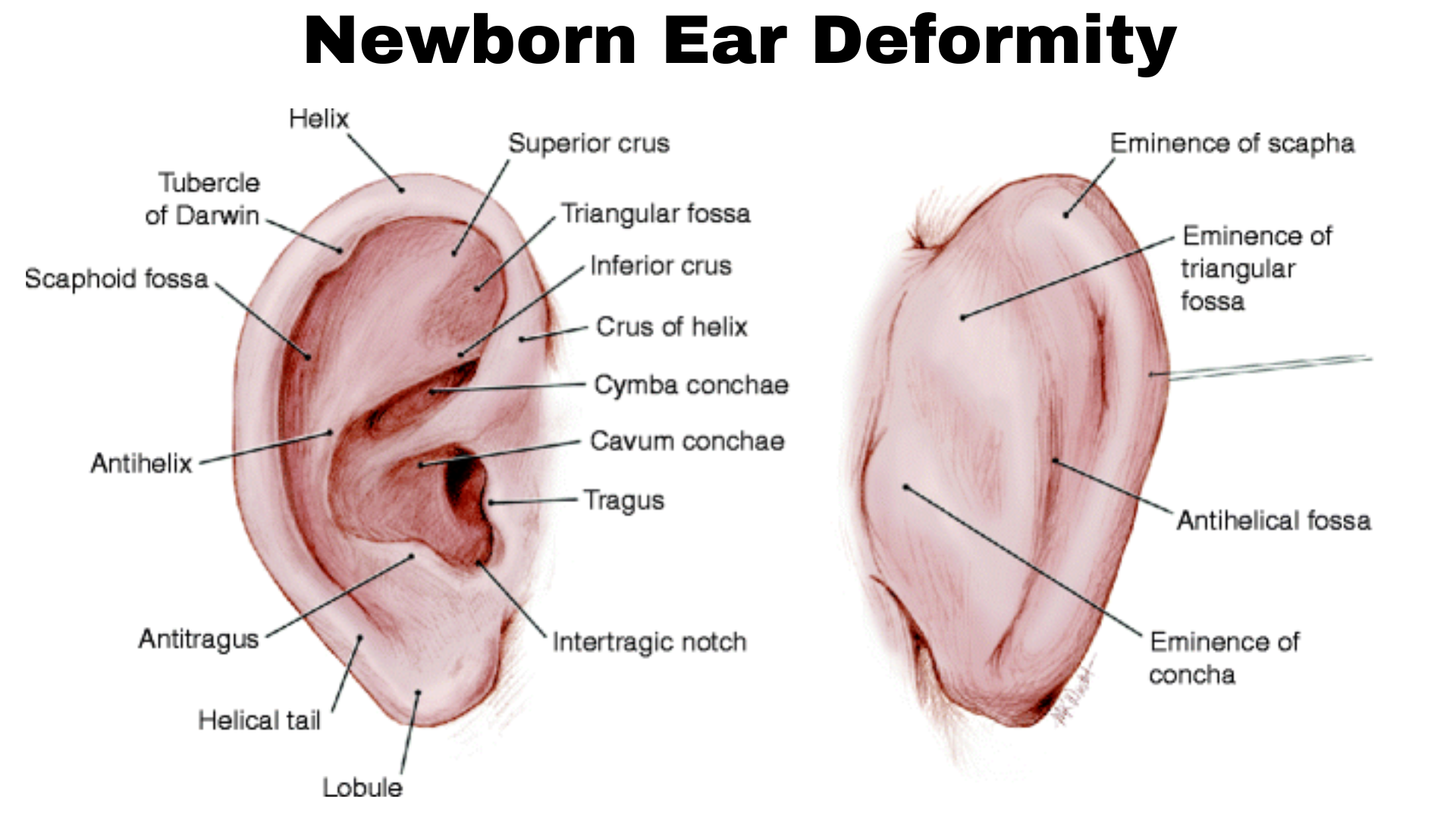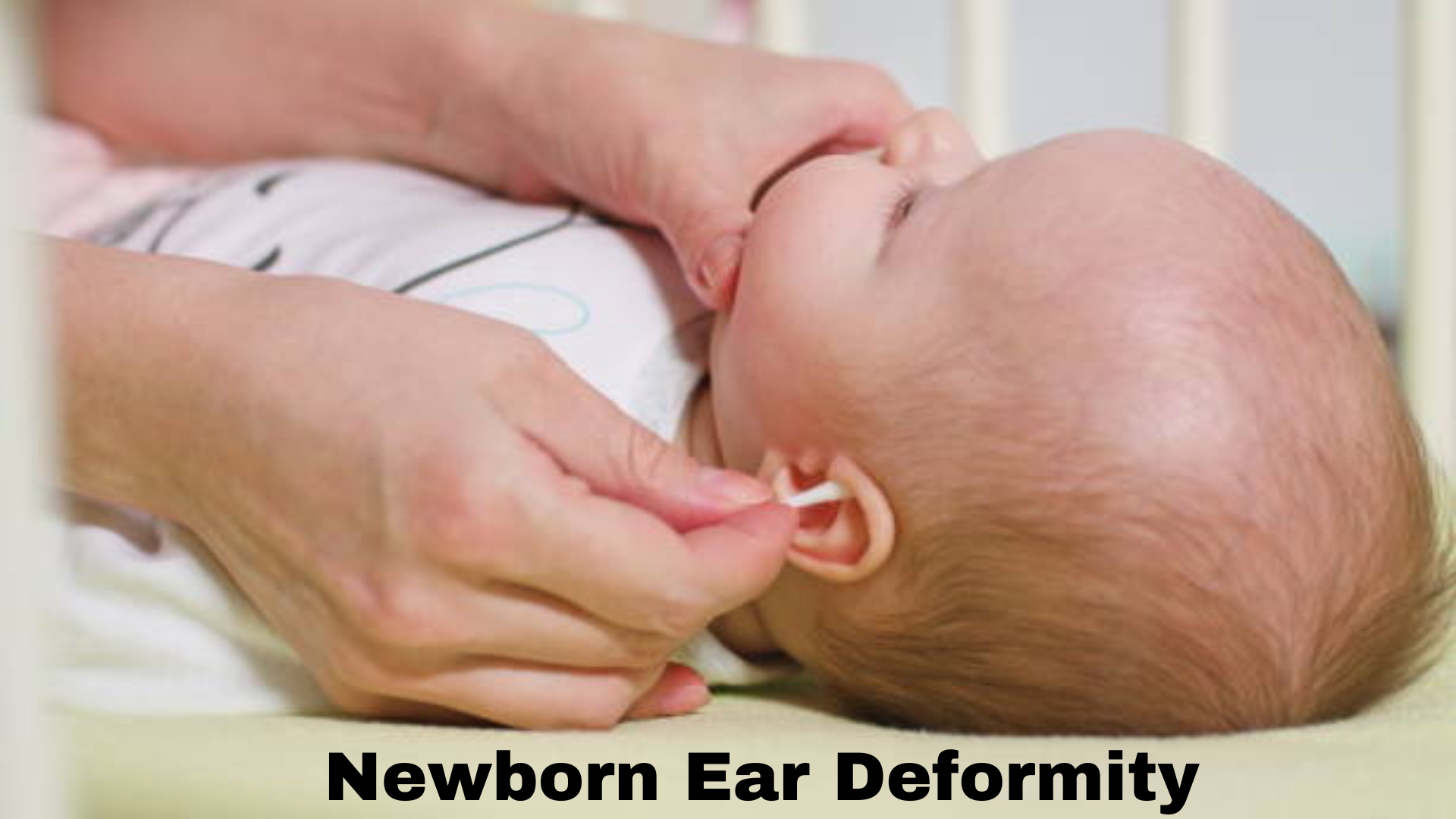Newborn Ear Deformity
Overview of Newborn Ear Deformity
Newborn Ear deformities are variations in the appearance and structure of the outer ear that may occur due to genetic factors, conditions in the womb, or after birth. These deformities can range from minor shape irregularities to more significant structural differences that impact the ear’s appearance and, in some cases, its function. Approximately one in every three to four thousand births may present a form of ear deformity, making it a relatively common congenital condition.
Importance of Early Detection
Early detection of Newborn Ear Deformity is crucial for several reasons. Firstly, the cartilage in a newborn is slightly pliable and responds well to non-surgical molding treatments within the first few weeks of life, offering a window of opportunity for effective correction without surgery. Early intervention can significantly improve cosmetic outcomes and, in cases where the deformity affects ear function, can also help prevent hearing issues and developmental delays associated with poor auditory input.
- Enhances treatment effectiveness by addressing health issues at an earlier, more manageable stage.
- Reduces the risk of severe complications, leading to better long-term health outcomes.
- Often results in less invasive treatments and lower healthcare costs.
- Increases the chance of recovery and survival rates, particularly in chronic diseases and cancer cases.
Understanding Newborn Congenital Ear Deformities
Types of Newborn Ear Deformity
Newborn ear deformities are variations from the standard shape and structure of the ear present at birth. These deformities can range from mild to severe and may affect one or both ears. They are categorized into two main groups: deformational (or non-structural) and structural anomalies. Here’s an overview of common types:
- Stahl’s Ear Deformity: Characterized by an extra fold of cartilage, giving the ear a pointed shape, reminiscent of an elf’s ear.
- Constricted Ear: Also known as a “cup ear,” this deformity features a rim of the ear that appears tight or constricted, potentially making the ear look smaller.
- Cryptotia: The upper part of the ear seems to be hidden beneath the scalp skin, making the ear appear partially buried.
- Lidding: The upper part of the ear folds over the ear itself, creating a lid-like appearance.
- Prominent Ear: This is when the ear sticks out more than usual from the side of the head. It’s one of the most common ear deformities.
Structural Anomalies
Lop Anomalies are more complex and involve malformation or absence of the ear’s cartilage.
- Microtia is a condition in which the ear is underdeveloped and significantly smaller than normal. It can range from mild to severe and can affect hearing.
- Anotia: The most severe form of microtia, where the external ear is completely absent.
- Atresia is the absence or closure of the ear canal, often occurring alongside Aural Atresia, which can affect hearing.
- Preauricular Tags and Pits: Small skin tags or indentations occur near the front of the ear or on the cheek.
Causes of Newborn Ear Deformity
The exact cause of newborn ear deformities is often challenging to pinpoint and can result from genetic and environmental factors. Genetic predisposition can be significant, especially in conditions like prominent ears. Environmental factors might include pressure on the baby’s baby’s early pregnancy or a lack of space in the womb, leading to folding or deformation of the ear. In some cases, external factors like prolonged pressure against the infant’s birth can also contribute to or exacerbate existing deformities.
- Genetic factors: Inherited traits can lead to ear deformities.
- Intrauterine pressure: Positioning in the womb may cause temporary or permanent ear shape changes.
- Amniotic band syndrome: Fibrous bands in the womb can constrict body parts, including the ears, leading to deformities.
- Birth trauma: Physical stress during delivery can cause ear deformities.
Diagnosing Newborn Ear Deformity
Diagnosing Newborn Ear Deformity typically involves a physical examination by a pediatrician or a specialist in pediatric ear deformities, such as a plastic surgeon or otolaryngologist. The assessment focuses on the ear’s appearance and structure and any impact on hearing abilities. In some instances, imaging tests might be conducted to examine the internal structures of the ear, especially if there are concerns about hearing impact. Early diagnosis is critical to taking advantage of non-invasive correction techniques and planning for necessary interventions to ensure the best possible outcomes for the child. Visit my other post.
Treatment for Deformity Correction of Infant Ear Anomalies
The approach to treating newborn ear deformities depends on the type of deformity, its severity, and the child’s age when the treatment begins. Treatments for newborn ear deformities range from non-surgical interventions, most effective when initiated early, to surgical options for older children or more severe deformities.
Non-Surgical Treatments
For Newborn Ear Deformity, Non-surgical treatments are most effective during the newborn period when the ear cartilage is still soft and moldable due to maternal estrogens. This phase typically lasts for the first few weeks of life.
Molding Therapy: Procedures and Effectiveness
Molding therapy involves using custom-made devices or tapes to reshape the ear gently. The most common method, ear molding or splinting, uses soft, malleable materials to hold the ear in the desired shape. The effectiveness of molding therapy is high, especially if started within the first 1-2 weeks of life, with many cases seeing significant improvement within 4 to 6 weeks of treatment. The non-invasive nature and high success rate of ear molding make it the first line of treatment for many types of newborn ear deformities.
At-home Care Strategies of Newborn Ear Deformity
For the prevention of newborn Ear Deformity, Parents are often involved in the care process, especially with at-home molding techniques. This includes carefully following the instructions for applying and maintaining the ear molds, ensuring the baby is comfortable, and monitoring the skin for any signs of irritation. Regular follow-up visits are crucial to adjust the molds and assess progress.
Surgical Treatments
Surgical treatments for newborn ear deformities are considered when non-surgical methods are not effective or suitable or if the diagnosis and treatment initiation happens beyond the early weeks of life when the ear cartilage is most pliable. These procedures are typically reserved for more significant deformities or older children, as the ear cartilage hardens over time, making non-invasive methods less effective. Here’s a view of surgical treatments for newborn ear deformities:
When Surgery is Recommended
In newborn ear deformities, surgery is typically recommended for severe deformities that cannot be corrected with molding, for older children whose ear cartilage has become too firm for molding to be practical, or where non-surgical treatments have been unsuccessful. Surgery is usually not considered until the child is at least 5 to 6 years old, as the ear reaches its total size by then, reducing the risk of altering the surgical results as the child grows.
Surgery is generally recommended in the following scenarios:
- Non-surgical methods (like ear molding) have been tried and were not successful.
- The child is older, and the ear cartilage has become too firm for molding to be practical.
- The deformity is severe, affecting not just the aesthetics but potentially the function of the ear, such as hearing.
Types of Surgical Procedures in Newborn Ear Deformity
Surgical options vary based on the type of deformity. Otoplasty, one of the most common procedures for correcting prominent ears, involves reshaping the ear cartilage through incisions behind the ear. For other types of deformities, surgery may include cartilage grafting (taking cartilage from another part of the body to reconstruct the ear) or other reconstructive techniques tailored to the specific deformity.
- Otoplasty is one of the most common procedures for correcting protruding ears. The surgery involves reshaping the ear cartilage through incisions behind the ear, allowing the surgeon to sculpt the ear into a more natural shape and position.
- Cartilage Grafting: Cartilage grafting might be necessary for deformities that cannot be corrected by reshaping alone. This procedure involves taking cartilage from another part of the patient’s body (e.g., the ribs) and reconstructing the ear.
- Ear Reconstruction: A more complex reconstruction might be required in severe deformities or ear absence. This can involve multiple stages of surgery to build a new ear structure that resembles a natural ear as closely as possible.
Aftercare and Follow-up
Newborn Ear Deformity is a crucial component of both non-surgical and surgical treatments. For non-surgical interventions, parents must ensure that the devices are used as directed and that any signs of discomfort or skin issues are addressed promptly. Surgical aftercare often involves wearing bandages for a specified period, avoiding activities that could injure the ear, and attending follow-up appointments to monitor healing. Follow-up visits are essential for assessing the treatment and planning additional interventions to achieve the best possible aesthetic and functional results. Regular monitoring helps identify and manage potential complications early, ensuring a smooth recovery.
FAQ of Ear Deformities in Newborns
1. What causes Newborn Ear Deformity?
Ear deformities in newborns can result from a combination of genetic factors and environmental influences, including pressure on the ears in the womb or after birth.
2. How joint are Newborn Ear Deformity?
Ear Newborn Ear Deformity is relatively common, affecting many newborns to varying degrees. Some estimates suggest that up to 15% of babies have some form of ear deformity at birth.
3. Can Newborn Ear Deformity correct themselves over time?
Some mild ear deformities may improve or resolve independently within the first week of life as the baby grows and the ear cartilage strengthens. However, more pronounced deformities usually require intervention.
4. What is ear molding therapy, and how does it work?
Ear molding therapy is a non-surgical treatment that involves applying a custom-made soft brace to the baby’s baby and gently reshaping the ear cartilage, which is very malleable in the first few weeks after birth.
5. How effective is ear molding therapy?
Ear molding therapy can be highly effective when started within the first few weeks of life. Success rates exceed 90% for many types of deformities.
6. When is surgery considered for correcting Newborn Ear Deformity?
Surgery is usually considered if non-surgical treatments are unsuccessful or if the deformity is diagnosed after the ear cartilage has become less malleable, typically around the age of 5 or 6.
Conclusion
Newborn Ear Deformity is essential for the well-being and development of affected children. Early detection and intervention are crucial to achieving the best outcomes with various non-surgical and surgical treatments available for Newborn Ear Deformity. While some ear deformities can improve over time, proactive treatment can significantly enhance a child’s, self-esteem and overall quality of life as they grow. Parents and caregivers should be encouraged to seek regular pediatric evaluations to address any concerns promptly, leveraging advancements in medical science to provide adequate care for Newborn Ear Deformity.


1 thought on “Newborn Ear Deformity with Compassion and Care”